
views
Searching for Someone after a Disaster

Search for the person with Google Person Finder. This site runs a check-in service for areas hit by recent natural disasters. You can access it here: https://google.org/personfinder/global/home.html Click on the three bars icon in the top left corner and click on the natural disaster you’re searching for. Then, click the blue “I’m looking for someone” button and type in the person’s name to search.

Use the Facebook Safety Check feature. Use a search engine to search for “Facebook Safety Check” and the area and type of disaster, such as, “Facebook Safety Check Mexico earthquake.” Click on the link, which should mention something like “The Earthquake in Mexico.” Click the link on the left side that says “Friends in Area.” If the person if your Friend on Facebook, you’ll be able to see if they’ve marked themselves as safe, or haven’t responded yet. To find out if a friend in the area is safe, you can click the button next to the person’s name that says “Ask if Safe.”
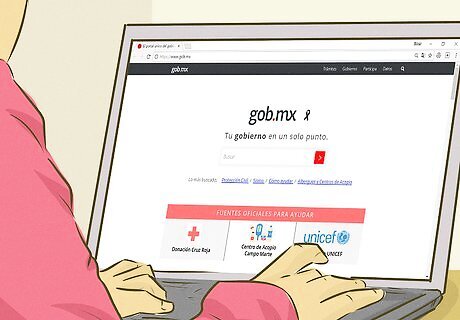
Check for information on the Mexican government’s website. In the case of a major natural disaster in Mexico, the government website will be updated with tools to help you locate missing loved ones. You can access the government’s website here: https://www.gob.mx/ For example, following an earthquake, the government will post a map of collapsed buildings in the affected area. Looking at this map can help you determine if the person was in an area hit by dangerous structural damage. This doesn’t mean they’ve necessarily been injured, but you can get a good idea of the damage experienced by their area.

Contact a missing person using apps that don’t use the Internet. Some people affected by natural disasters have been able to contact loved ones using applications that don’t require Internet service. Look for simple messaging apps that work similarly to walkie-talkies, which allow you to simply push a button to talk. Though you and the missing person will both need to have the app to contact each other, it’s worth downloading it and giving it a try.

Contact your embassy in Mexico. Let them know that you’re looking for a person who may have been impacted by the natural disaster. They can help you to contact the local authorities and give you other information to help you locate the person. The embassy will probably be handling many calls like yours, so be calm, polite and patient. Speak clearly and ask what you can do to aid the process. You can call the US Embassy by dialing 011-52-55-5080-2000. To call the US Embassy from Mexico, dial 55-5080-2000. Contact the British Embassy by calling 020-7008-1500. To call the British Embassy from Mexico, call 0052-55-1670-3200.
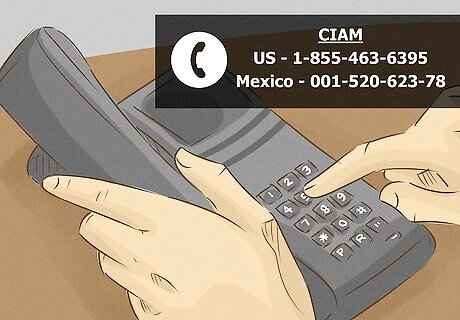
Contact the Mexican embassy or consulate in your country. If the person you’re looking for is a Mexican citizen, call the Mexican Embassy in your country for information and to notify them of a missing person. Stay calm and speak clearly and politely, and ask what you can do to help find the person. You can also call the Mexican embassy’s Center for Information and Assistance for Mexicans (CIAM). They can give you more information on the disaster and help you find missing persons. In the US, you can call CIAM by dialling 1-855-463-6395. In Mexico, dial 001-520-623-78.
Finding a Missing Person on the Border
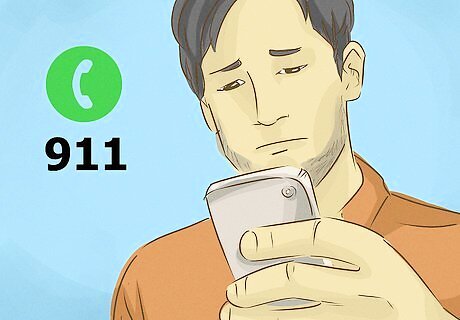
Call emergency services if the person is actively lost in the desert. If you have spoken with the person in the last three days and think they may be missing in the desert, call 911 immediately. Tell them the person’s last known location, their name, and what they look like. The police or emergency services may also involve Border Patrol. Although you may be worried about contacting American authorities, especially if the person crossed the border illegally, it may be the only way to save the person’s life.

Contact non-governmental organizations (NGOs) in Mexico and the US. As a secondary or alternative solution to contacting American authorities, you could call an NGO or non-profit dedicated to finding missing people along the border. These services can help families looking for a relative who’s gone missing while trying to cross the border. You can search for them online. You can also use the Mexican government’s migrant safety agency, Grupos Beta, which provides rescue and first aid to migrants. They will provide services regardless of the person’s nationality or immigration status.
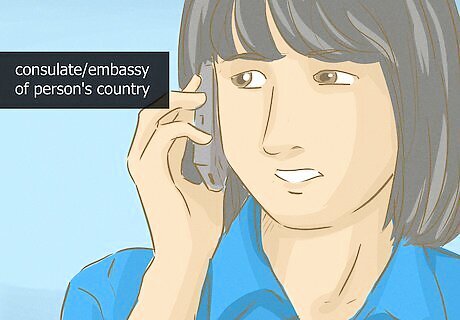
Call the consulate or embassy of the person’s home country. Explain that you’re looking for a person who went missing near the border. Tell them the name and last known location of the person, and describe what they look like. Try to contact the consulate nearest to the place where the person went missing. The consulate authorities will likely notify Border Patrol of the situation. You can also contact the consulate for information if you think the person has been detained at the border. They will only give you information about the detained person if you are an immediate family member, like a spouse, parent, sibling, or child. Be prepared to give the person’s full name and date of birth.

Contact the Office of Refugee Resettlement if the person a refugee. This agency helps refugees from Central America, South America, Africa, and anyone else claiming asylum in the United States. If you think the person might be in their custody, call them at 800-203-7001. Stay calm and be polite and patient. Give your name, phone number, and details about the person, such as their name and your relationship to them.

Contact the US Immigration and Customs Enforcement (ICE). If you think the person may have been detained, you can call the ICE, providing the person’s name, country of origin, and your relationship to them. Stay calm and remember that you have the right to ask about a person’s whereabouts, especially if the person if a family member. You can also search for the person in the ICE’s online detainee locator. Enter the person’s full name and country of origin to see if the person is in ICE custody. Call the ICE at 1-888-351-4024. If you can’t find the person in the database, try spelling their name differently or switching their first and last names around, in case the name was entered incorrectly. You can also narrow the results by adding the person’s middle name or date of birth. The locator can only search records for people over the age of 18.

Call forensic missing persons groups if the person may have passed. If you’re unable to find the person through other means, you may want to look into organizations that help families find relatives who have perished on the border. These groups can collect DNA from family members and search forensic systems on the border for the missing person. Remember that checking with these agencies doesn’t necessarily mean that the person has passed away. Stay strong and don’t give up hope. You can also call state medical examiners directly.
Finding a Long-Term Missing Person

Recall the last time you heard from or of the person. Gathering all the information you know about the person will help you find them. Write down their name, what they looked like, where you last saw them, and when you last heard from them. The more details you can provide, the better. If you can, talk to any of the person’s friends or family that you know.

Search for them on the Internet. Head to all the major search engines and start typing in the person’s name. Try Google, Yahoo, and Bing. Place the person’s name in quotation marks and try entering in general information about them as well. For example, type in “Thomas White”, “Thomas White Mexico”, or “Thomas White truck driver” to narrow down your search. Different search engines access unique data sets and return results differently, so you might find good information on one that isn’t available on another.

Check on all social media sites. Search the person’s name on major sites like Facebook, Twitter, LinkedIn, and Google+. You can also check older sites, like MySpace. Even old or abandoned profiles can be helpful in your search.

Search missing person databases. Look for global online databases, which will let you search in Mexico and all over the world for the missing person. If the person turns up in one of these databases, you may be able to see where they’re living and where they work, and be able to get in touch with them.

Notify your country’s embassy in Mexico. Even if the person has been missing for a long time, it’s a good idea to contact your country’s embassy or consulate in Mexico to let them know you’re trying to track them down. The embassy can get in touch with local authorities and give you any information they have about the person. Find your embassy’s phone number online from an official government site. Contact the US Embassy by calling 011-52-55-5080-2000. To call the US Embassy from Mexico, dial 55-5080-2000. Contact the British Embassy by calling 020-7008-1500. To call the British Embassy from Mexico, call 0052-55-1670-3200.
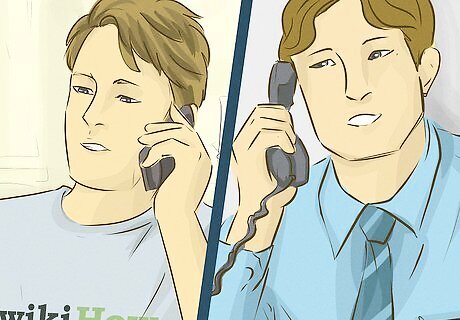
Hire an international private investigator. If your search efforts aren’t turning up any results, try calling a private investigator. Ask them how much experience they have investigating in Mexico and finding missing persons, and ask for their track record on previous cases. Private investigators can often be expensive, but their professional services may be worth the money if you’re determined find the person.

















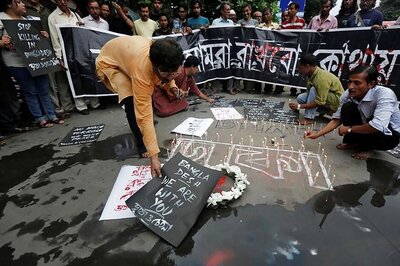

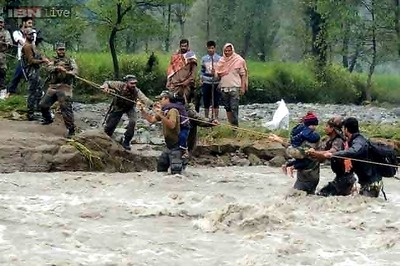
Comments
0 comment